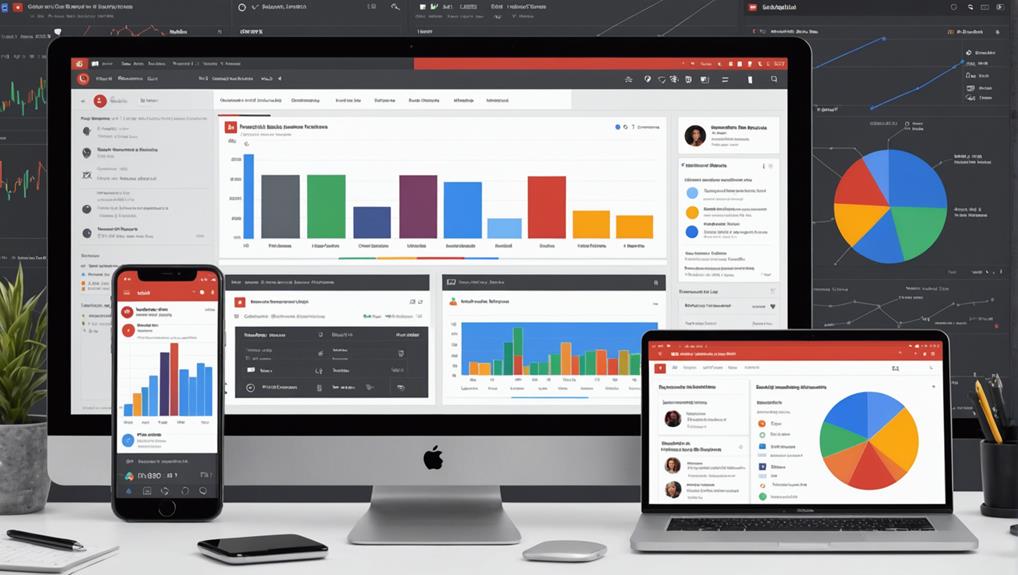Accurately comparing YouTube video metrics is essential for optimizing content strategies. Begin by accessing YouTube Analytics to evaluate watch times and engagement metrics. Utilize dot plots to visually compare performance over timeframes, identifying trends and discrepancies. Assess viewer engagement through average view duration and audience retention graphs, focusing on metrics like likes, shares, and comments to gauge emotional response. Analyzing content trends using the dot plot feature can reveal successful strategies and necessary adjustments for optimization. Finally, optimize for improvement by experimenting with titles and thumbnails. Understanding these core elements will provide deeper insights into strategic enhancements.
Key Takeaways
- Utilize the YouTube Analytics dashboard to compare watch time and average view duration across videos.
- Leverage dot plots for visual comparison of video performance metrics over different timeframes.
- Assess audience retention graphs to identify viewer drop-off points and compare engagement trends.
- Analyze traffic sources and demographic data to tailor content for improved reach and engagement.
- Experiment with titles and thumbnails using analytics insights to enhance click-through rates and viewer retention.
Access YouTube Analytics
With a strategic approach to managing your YouTube channel, accessing YouTube Analytics becomes a pivotal step in understanding and optimizing video performance. By logging into the Google account associated with your channel and directing yourself to YouTube Studio, you gain access to a wealth of insights via the Analytics dashboard. This platform provides essential data points such as total watch time, average view duration, and engagement metrics, offering an extensive view of how your content is performing.
The YouTube Analytics dashboard is divided into key components: Content, Audience, and Research. Each section allows you to explore deeper into specific performance areas, enabling you to identify unique viewers and assess their engagement with your videos. Regularly updated, this data is instrumental for making data-driven decisions to enhance your channel’s success.
Utilizing the date selector, you can focus on specific time periods to compare video performance. Advanced Mode further empowers you to create custom charts and perform detailed comparisons, helping you to pinpoint top performers and understand what drives viewer engagement.
Leverage Dot Plots
Understanding video performance through YouTube Analytics establishes a foundation for further detailed analysis using dot plots. Dot plots, or scatterplots, provide a visually intuitive means to compare YouTube metrics across different timeframes, such as the first 24 hours, 7 days, or 28 days post-publication.
By accessing dot plots through YouTube’s advanced channel analytics, creators can customize which metrics, like views or impressions, to analyze against various publishing dates. Each point on a dot plot represents a specific video’s performance, offering granular insights into engagement and viewer retention when hovered over.
Utilizing dot plots allows creators to swiftly identify trends and discrepancies in video performance. This visual tool enhances understanding by highlighting which content resonates with audiences and which does not.
By discerning patterns among high-performing and low-performing videos, creators can derive actionable insights to refine their video marketing strategies. Such analysis aids in spotlighting engaging content while identifying areas for improvement, thereby optimizing future content strategies.
Evaluate Viewer Engagement
Effectively evaluating viewer engagement is critical for understanding the impact and reach of your YouTube content. To assess content effectiveness, it is vital to examine the Average Percentage Viewed, which highlights the average amount of time your audience spends engaging with your videos. This metric directly correlates with viewer retention, offering insights into how well your content captivates the audience.
Engagement metrics such as likes, shares, and comments provide valuable insights into the emotional response and interaction levels of viewers. High engagement in these areas often leads to subscriber growth, as engaged viewers are more likely to continue watching and sharing your content.
Additionally, leveraging the audience retention graph can help pinpoint specific moments where viewers drop off, enabling creators to refine their content for better retention. Comparing the Average View Duration across different videos allows you to track trends and identify which content types hold attention longer, thereby informing strategic adjustments.
Monitoring re-watches also uncovers popular segments that resonate with your audience, offering further insights into viewer preferences. Understanding these elements guarantees that each video after seeing the data can be optimized, ultimately enhancing content effectiveness and viewer engagement.
Analyze Content Trends
Building on insights gained from evaluating viewer engagement, analyzing content trends is a strategic approach to refining your YouTube strategy. Start by examining video metrics such as watch time, engagement, and audience retention. These metrics reveal themes and content strategies that contribute to successful content.
Utilize YouTube Analytics’ Dot Plot feature to compare these key metrics over specified timeframes. This visualization helps identify performance trends, showing which topics resonate most with your audience.
Furthermore, analyzing traffic sources is essential. Understanding how viewers discover your videos allows for optimizing promotional strategies, guaranteeing the right content reaches the right audience. For instance, if a significant portion of traffic originates from social media, enhancing your social media promotion could amplify reach.
Demographic data offers another layer of insights, helping tailor future content to your audience’s preferences. This guarantees relevance and engagement with target viewers, thereby enhancing video metrics.
Recognizing patterns in lower-performing videos, such as ineffective titles or thumbnails, allows for strategic adjustments. By aligning these elements with successful content strategies, you can enhance viewer attraction and retention.
Consequently, regularly analyzing content trends is imperative for sustaining and improving your YouTube channel’s growth.
Optimize for Improvement
Optimizing for improvement on YouTube necessitates a data-driven approach to content refinement. Analyzing the first 24 hours of video performance using dot plots can reveal immediate engagement trends, providing essential insights for adjusting future content strategies.
Leveraging analytics via YouTube’s platform allows creators to discern patterns in watch time and click-through rates, which are crucial indicators of video performance and viewer interest.
A deeper examination of viewer retention metrics is fundamental to identify segments that maintain audience attention. By enhancing these aspects in subsequent productions, creators can optimize viewer appeal and foster channel growth.
Furthermore, understanding traffic sources can guide strategic decisions about where to promote content and how to reach target audiences effectively.
Experimenting with titles and thumbnails, particularly those featuring trending keywords, can boost viewership by attracting initial clicks. By drawing common themes from top-performing videos—such as popular topics and effective thumbnail designs—creators can replicate successful elements, thereby enhancing the likelihood of future success.
Regularly reviewing and adapting content strategies based on insights from both high and low-performing videos guarantees that channels remain responsive to audience preferences, thereby maximizing overall engagement and growth potential.
Frequently Asked Questions
How to Compare Two Youtube Videos?
To compare two YouTube videos, assess video engagement, audience retention, and thumbnail effectiveness. Analyze content length, posting frequency, niche comparison, and comment sentiment. Examine call to action, viewer demographics, and shareability analysis for thorough insights.
What Are KPIS for Youtube?
Key performance indicators for YouTube include engagement rate, audience retention, click-through rate, traffic sources, watch time, and subscriber growth. These metrics, alongside video reach, demographic insights, content type, and posting frequency, provide thorough content performance analysis.
How Do You Analyze Youtube Performance?
Analyzing YouTube performance involves evaluating audience engagement through metrics like watch time and viewer retention, measuring click-through rates, and examining content strategy. Consider thumbnail effectiveness, niche targeting, SEO optimization, social sharing, and comment analysis to refine strategies.
What Is the Metric That Determines Youtube Success?
The metric determining YouTube success is multifaceted, encompassing engagement rates, viewer retention, and subscriber growth. Additionally, content quality, audience demographics, click-through rates, video length, upload frequency, niche relevance, and competition analysis play significant roles in evaluating performance.
Conclusion
To sum up, the systematic comparison of YouTube video metrics necessitates a multifaceted approach involving access to YouTube Analytics, utilization of dot plots, and evaluation of viewer engagement. Analyzing content trends provides invaluable insights into audience preferences, while optimization strategies facilitate continuous improvement. This data-driven methodology enables content creators to refine their strategies, maximizing viewer retention and engagement. By employing these techniques, the effectiveness of video content can be greatly enhanced, fostering sustained growth and increased visibility on the platform.




